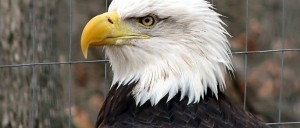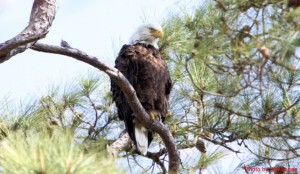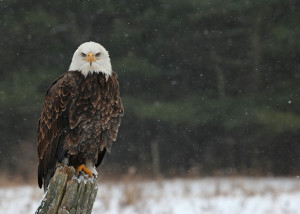
ST. GEORGE — If you’ve ever seen a bald eagle in the wild, you know it’s an experience that can take your breath away.
On Feb. 13, you’ll have a chance not only to see bald eagles, but to learn more about them when the Utah Division of Wildlife Resources will hold its annual Utah Bald Eagle Day.
Bald Eagle Day is free. You can see eagles at five locations across the state. Viewing times vary depending on the site you visit.
Southern Utah

Rush Lake Ranch, located on the Minersville highway (SR-130) about 12 miles north of Cedar City.
Viewing will take place from 9 a.m. to 2 p.m.
Bob Walters, watchable wildlife coordinator for the Division of Wildlife Resources, says spotting scopes will be available at each viewing site so you can get a good look at the eagles. Biologists and volunteers will also be on hand to help you spot the eagles and answer your questions, he said.
You can also pick up a Bald Eagle Day button. Handouts and information about bald eagles, wildlife watching and birding opportunities in Utah will also be available.
The button and information are free.
Central Utah
Fountain Green State Fish Hatchery, located east of Nephi.

Viewing will take place at Fountain Green from 9 a.m. to 3 p.m. Free tours of the Fountain Green State Fish Hatchery will also be offered.
If you’re coming from the north, you can reach the hatchery by taking Interstate 15 and exiting the freeway at the second Nephi exit (Exit 225). After exiting the freeway, turn east on state Route 132 and travel about 10 miles. About 1 mile before the city of Fountain Green, a Bald Eagle Day sign will point you to an access road that leads to the hatchery.
Once you reach the hatchery, you’ll be given a driving map of the Sanpete Valley that highlights the best areas in the valley to view eagles. Literature, displays and bathroom facilities will also be available at the hatchery. Spotting scopes will be set up at a viewing location about one mile from the hatchery where eagles often gather in a large tree.
Northern Utah
Salt Creek Waterfowl Management Area (Compton’s Knoll), located about 10 miles northwest of Corinne.

Viewing at Salt Creek will take place from 10 a.m. to 3 p.m.
To reach the WMA, take Exit 365 off I 15 and travel west on SR 83 through Corinne. Stay on Sr 83 until you get to 6800 West (Iowa String). Travel north to 6800 N. Drive west on 6800 N. until you reach the Salt Creek WMA/Compton’s Knoll Watchable Wildlife site.
Farmington Bay Waterfowl Management Area, located on the west side of Farmington at 1325 W. Glovers Lane (925 South.)
Viewing at Farmington Bay will take place from 9 a.m. to 4 p.m.
To reach the Farmington Bay WMA, follow these directions:
If you’re traveling from Salt Lake City and other areas south of Farmington, travel north on I-15 to Exit 322. (The exit is just after you pass under the Glovers Lane overpass.) Where the ramp forks, stay right. Just off the exit ramp, turn right onto the frontage road, and continue south to the stop sign. Turn right onto Glovers Lane and follow it west.
To reach the Farmington Bay WMA, travel to 1325 W. Glovers Lane, and turn left.
If you’re traveling from Ogden and other areas north of Farmington, travel south on I-15 to Farmington. Take Exit 325 (the Lagoon/Park Lane exit). The exit will take you to Park Lane. Turn right (west) on Park Lane. Park Lane will bear south and run into Clark Lane. Turn right (west) onto Clark Lane and continue to the first four-way stop, which is 1525 W. Turn left (south) onto 1525 W., and continue for about one mile until the street ends at Glovers Lane.
To reach the Farmington Bay WMA, turn left (east) onto Glovers Lane. Travel to 1325 W. Glovers Lane, and then turn right (south).
Northeastern Utah

Split Mountain/Green River, located north of Jensen and below the Dinosaur Quarry in Dinosaur National Monument.
Viewing will take place from 9 a.m. to 3 p.m.
To reach the site, drive north from Jensen, Utah on SR 149 towards the Dinosaur Quarry.
Your first stop should be at the staging area located just inside the DNM boundary. Displays and spotting scopes will be available at the staging area, and you might be able to see bald eagles and other raptors in the distance. Biologists will also be available to answer your questions.
From the staging area, biologists will direct you to other sites where you may have better views of eagles and other wildlife of interest. In past years, visitors have seen bald and golden eagles hunting and feeding, as well as prairie falcons, hawks, mule deer, river otters, pheasants, turkeys, sandhill cranes, porcupines, mergansers, Canada geese and other wildlife.
Depending on when you attend, you can also see a live bird of prey close up. For part of the day, at least one hawk will be on display at the staging area. Melissa Wardel, a local falconer, usually brings her hawk to the staging area around mid-morning. She and the hawk will remain at the staging area until the bird gets tired of the crowd.
During your trip, you may want to stop and see the dinosaur bones and exhibits at DNM. This year, the National Park Service is waiving entrance fees on Feb. 14, so it won’t cost you anything to visit the monument’s Dinosaur Quarry and see the bones.
The Dinosaur Quarry and the visitor center are open from 9 a.m. to 5 p.m. The visitor center also includes a small bookstore and warm bathrooms.
The best time to see eagles on Feb. 13 depends on what’s most important to you — staying as warm as possible or seeing more eagles.
If staying warm is most important, attend late in the morning or early in the afternoon. The warmer temperatures during this time of the day are especially important if you bring young children with you, Walters said.
Late morning and early afternoon is also the best time to get a clear view of the eagles.
If you want to see the greatest number of eagles with fairly good light conditions and reasonably warm temperatures, attend between 2 and 4 p.m.
After 4 p.m., eagles at many of the viewing locations will start flying to trees to roost for the night.
If you want to see the greatest number of eagles, Walters said, mid to late afternoon is usually the best time to attend, before the eagles fly to their roost sites.
If you attend Bald Eagle Day, dress in warm clothes and bring waterproof boots. Also, if you want to take photos of the eagles, bring a telephoto lens.
The eagles will be a fair distance from the viewing areas, Walters said.
Walters started Bald Eagle Day to introduce people to Utah’s wildlife.
I started Bald Eagle Day because I wanted to make people aware of the wildlife around them, he said. I wanted to whet their appetite to see more.
Since it began, Bald Eagle Day has become Utah’s most well attended, and one of its most enjoyed, wildlife-viewing events.
I think the event is still accomplishing its purpose, he said.
For more information about Bald Eagle Day, call Walters at 801-209- 5326, or the Utah Division of Wildlife Resources offices in Ogden, Springville, Vernal or Cedar City.
Email: [email protected]
Twitter: @STGNews.com